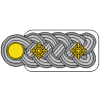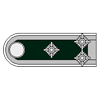
Hosted by Darren Baker
How do I glue already painted parts
JoeyKast44

Joined: September 23, 2014
KitMaker: 144 posts
Armorama: 124 posts
Posted: Thursday, October 23, 2014 - 10:45 PM UTC
Sorry if this is in the wrong topic, but I'm confused as to how people glue their already painted parts to their model without damaging the paint work. I'm sure, i'm just too entusiastic with the glue but is there a special glue or technique? 


bison126

Joined: June 10, 2004
KitMaker: 5,329 posts
Armorama: 5,204 posts

Posted: Thursday, October 23, 2014 - 11:08 PM UTC
Hello,
it depends of the final destination of your part, if it needs a strong contact with the other part in contact or not.
The best is to ensure a proper contact between parts. Thus you'll probably have to remove the paint from the contact surfaces before applying glue.
If the part is less likely to be touched while handling the model, you can just use some white glue. I do it for the crew gear I add on my models. For this method to work, the parts should better lie on a nearly horizontal surface or a slightly sloped one. On a vertical surface, the white glue is not strong enough to hold the part.
HTH
Olivier
it depends of the final destination of your part, if it needs a strong contact with the other part in contact or not.
The best is to ensure a proper contact between parts. Thus you'll probably have to remove the paint from the contact surfaces before applying glue.
If the part is less likely to be touched while handling the model, you can just use some white glue. I do it for the crew gear I add on my models. For this method to work, the parts should better lie on a nearly horizontal surface or a slightly sloped one. On a vertical surface, the white glue is not strong enough to hold the part.
HTH
Olivier

RobinNilsson

Joined: November 29, 2006
KitMaker: 6,693 posts
Armorama: 5,562 posts

Posted: Thursday, October 23, 2014 - 11:17 PM UTC
It depends on what "glue" that is used. See post above about using white glue.
The strength of the bond when gluing painted parts depends on two things: the strength of the glue and how hard the paint clings to the surface. If the glue is strong but the paint lets go the part will still fall off.
Some glues will not creep under the paint but if you glue with strong solvents (sort of chemically welding the plastic) then the solvents can go under the paint and ruin a larger are of paint than the actual glued surface. Paint needs to be removed from the bond surfaces but solvent could spread under the anjoining paint.
Gluing with CA or epoxy could work, clean the paint from a smaller area and then glue with small amounts of glue so that glue doesn't squeeze out of the joint.
Another way is to drill holes and glue a rod through the surface where the part should be and then glue the part to the rod.
A third option is to glue before painting, either repainting the small added part afterwards or covering it with masking material to protect it from paint.
/ Robin
The strength of the bond when gluing painted parts depends on two things: the strength of the glue and how hard the paint clings to the surface. If the glue is strong but the paint lets go the part will still fall off.
Some glues will not creep under the paint but if you glue with strong solvents (sort of chemically welding the plastic) then the solvents can go under the paint and ruin a larger are of paint than the actual glued surface. Paint needs to be removed from the bond surfaces but solvent could spread under the anjoining paint.
Gluing with CA or epoxy could work, clean the paint from a smaller area and then glue with small amounts of glue so that glue doesn't squeeze out of the joint.
Another way is to drill holes and glue a rod through the surface where the part should be and then glue the part to the rod.
A third option is to glue before painting, either repainting the small added part afterwards or covering it with masking material to protect it from paint.
/ Robin
Biggles2

Joined: January 01, 2004
KitMaker: 7,600 posts
Armorama: 6,110 posts

Posted: Friday, October 24, 2014 - 02:34 AM UTC
Just carefully scrape off the paint where the parts make contact. 


PantherF

Joined: June 10, 2005
KitMaker: 6,188 posts
Armorama: 5,960 posts

Posted: Friday, October 24, 2014 - 04:22 AM UTC
That's why it's best to glue parts FIRST, then paint.
Jeff
Jeff
Giovanni1508

Joined: April 17, 2014
KitMaker: 652 posts
Armorama: 600 posts

Posted: Friday, October 24, 2014 - 06:00 AM UTC
Quoted Text
Sorry if this is in the wrong topic, but I'm confused as to how people glue their already painted parts to their model without damaging the paint work. I'm sure, i'm just too entusiastic with the glue but is there a special glue or technique?
Hi Joey,
Welcome! It is not a big matter: generally speaking, first build, then paint.
Then, small details always need to be glued after painting: in this case, scratch a little paint, then glue and touch-up at the end.
Of course, my suggestion: try, try and try...and enjoy modelling

Posted: Friday, October 24, 2014 - 06:27 AM UTC
The reason for removing paint from contact areas is that most plastic cements melt the mating surfaces and that is how they stick together. If paint is in the way this is prevented from taking place and the bond will be weak.
Posted: Friday, October 24, 2014 - 07:30 AM UTC
So, combining all of the above into a "best practice":
- Assemble most of the model before painting
- If parts/subassemblies must be painted during the build, then for best results scrape away the paint on the mating surfaces when bonding after painting.
* Different adhesives provide different levels of joint strenght, but for the adhesion of paint to the model is not great so pick your adhesivee accordingly.
- Be prepared to touch-up joints after adding prepainted parts.
If I do not have a visible interior, I tend to assemble the entire model prior to doing any painting with the exception of stowage and, in some cases, the road wheels. Then paint everything, add the remaining vehicle parts to the vehicle, and add decals. Then add any additional stowage, tarps, etc and then weather.
Your mileage may vary and be assured there are a thousand other guys doing things differently and getting great results.
HTH
Paul
- Assemble most of the model before painting
- If parts/subassemblies must be painted during the build, then for best results scrape away the paint on the mating surfaces when bonding after painting.
* Different adhesives provide different levels of joint strenght, but for the adhesion of paint to the model is not great so pick your adhesivee accordingly.
- Be prepared to touch-up joints after adding prepainted parts.
If I do not have a visible interior, I tend to assemble the entire model prior to doing any painting with the exception of stowage and, in some cases, the road wheels. Then paint everything, add the remaining vehicle parts to the vehicle, and add decals. Then add any additional stowage, tarps, etc and then weather.
Your mileage may vary and be assured there are a thousand other guys doing things differently and getting great results.
HTH
Paul
Posted: Friday, October 24, 2014 - 07:40 AM UTC
Before applying decals give the model a blow over with a gloss cote so that the decals don't silver, when the decals are on and set apply any washes you wish and then add your matt cote to seal everything before continuing your weathering.
JoeyKast44

Joined: September 23, 2014
KitMaker: 144 posts
Armorama: 124 posts
Posted: Friday, October 24, 2014 - 01:23 PM UTC
Thanks guys the advice is appreciated, I have a habit of over enthusiastically gluing parts, what glue would you recommend for PE, resin or just normal injection molded kits?
Posted: Friday, October 24, 2014 - 02:28 PM UTC
Resin = CA, Epoxy, Acryllic Gator glue in some cases PVA
PE = CA, Epoxy, in some cases PVA
Plastic I have become a huge fan of Tamiya extra thin in most cases.
If you hands like shovels PVA is not the stongest join.
Which glue you use depends on your need, CA is the most common, but I feel Epoxy provides the best all round joint.
PE = CA, Epoxy, in some cases PVA
Plastic I have become a huge fan of Tamiya extra thin in most cases.
If you hands like shovels PVA is not the stongest join.
Which glue you use depends on your need, CA is the most common, but I feel Epoxy provides the best all round joint.
TankManNick

Joined: February 01, 2010
KitMaker: 551 posts
Armorama: 543 posts

Posted: Friday, October 24, 2014 - 02:46 PM UTC
For small parts that are better painted separately, like say braille scale tools, I usually use a little CA and rely on a matt clear to tidy up glue overrun which will be glossy.
Biggles2

Joined: January 01, 2004
KitMaker: 7,600 posts
Armorama: 6,110 posts

Posted: Saturday, October 25, 2014 - 01:56 AM UTC
When using CA, like Zap-a-Gap, etc., never squeeze it out directly from the bottle. I squeeze out a little puddle into a bottle cap and apply where needed with a needle point. And keep away from the extra thin CA - it's way too runny and impossible to control. 


PantherF

Joined: June 10, 2005
KitMaker: 6,188 posts
Armorama: 5,960 posts

Posted: Saturday, October 25, 2014 - 02:57 AM UTC
For styrene plastic kits I use Ambroid Pro Weld liquid cement.
Very strong adhesive, low odor, dries fast and it applies with a brush so controlling the amount of cement used is very easy and one bottle goes a long way.
Jeff
Very strong adhesive, low odor, dries fast and it applies with a brush so controlling the amount of cement used is very easy and one bottle goes a long way.
Jeff
Posted: Saturday, October 25, 2014 - 01:50 PM UTC
Quoted Text
what glue would you recommend for PE, resin or just normal injection molded kits?
There are a number of glues on the market and you'll probably find that most of us use different glues for different situations. I usually have on hand 2 or 3 CA glues, 2 or 3 liquid styrene cements, gator glue, PVA, a couple of epoxies and epoxy putty, all used, in one circumstance or another, to bond parts. Oh, and don't forget that soldering is possibly the best way to join two pieces of PE brass together, if you have the skill, which, sadly, I generally do not! :-)
With pretty much every aspect of this hobby, the key is experimentation and finding out what works best for _you_.
HTH
Paul
JoeyKast44

Joined: September 23, 2014
KitMaker: 144 posts
Armorama: 124 posts
Posted: Saturday, October 25, 2014 - 10:41 PM UTC
I did do soldering for one semester at school.. a lot of equipment needed for my limited space.
BobJ

Joined: October 15, 2006
KitMaker: 27 posts
Armorama: 19 posts
Posted: Monday, October 27, 2014 - 06:39 AM UTC
Before painting, Poly cement.
After painting, Super glue (I use the gel, it has great control and doesn't run everywhere like the standard stuff!).
After painting, Super glue (I use the gel, it has great control and doesn't run everywhere like the standard stuff!).

justsendit

Joined: February 24, 2014
KitMaker: 3,033 posts
Armorama: 2,492 posts

Posted: Monday, October 27, 2014 - 07:20 AM UTC
Quoted Text
... (I use the gel, it has great control and doesn't run everywhere like the standard stuff!).
What Robert said. However, when using the SuperGlue Gel formula, it's helpful to have a bottle of 'Zip Kicker' CA accelerator handy, since parts will sometimes move out of position until the glue has fully cured.
I've used both the 'Zip Kicker' spray can and pump bottle versions. With the spray can, just spray a little onto a paper towel, hold it over the model and blow the vapors onto the area. Avoid spraying directly on the model — especially clear parts. With the pump bottle, I'll do something similar or dip a cotton swab and hold it close the parts. Sometimes, I'll just hold the cap close and blow at the parts (I don't use the included pump). I prefer the bottle over the spray can, since it doesn't particulate into the air as much.
—mike
 |















